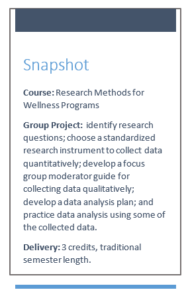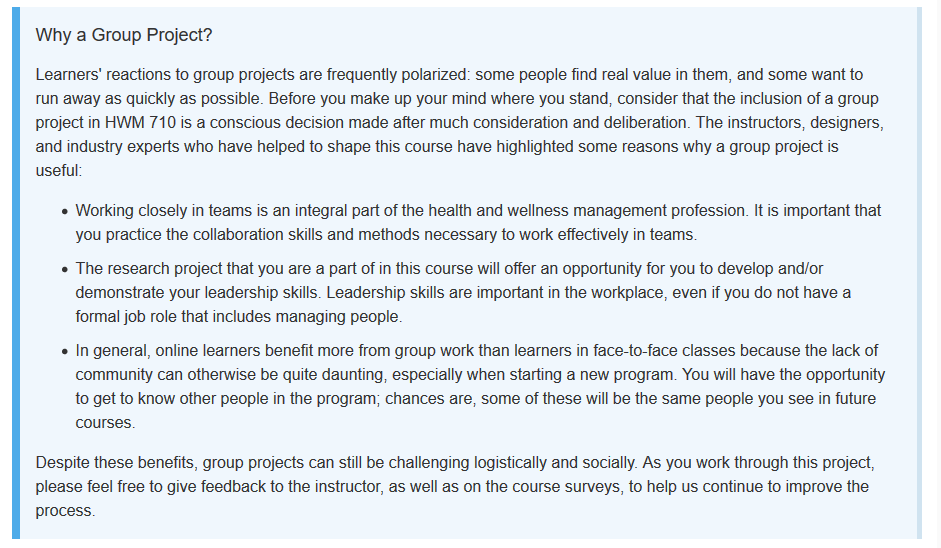Introduction

I was one of those students that always hated group projects because I invariably ended up with somebody who didn’t do their work and I figured I could do it better myself…I always thought students would feel the same way. But I was encouraged to try it out and it’s been great.
Like many students and instructors, Heather Herdman, PhD, entered into the fray of online group projects with trepidation; but, with input from other colleagues in the program and instructional designers, she made the commitment to give it a try.
We all know that students have responsibility for making group work successful and instructors have little control over what students do or don’t do, but we also have a responsibility to provide the best environment for the group work to occur. As instructors, there are things we can do to change the conditions of group work and impact the trajectory to increase the likelihood of success. Today we’re going to take a close look at Heather’s approach to this project as a way to uncover keys to successful teaching with online group projects.
You can think about your work related to online group projects as fitting into three phases: planning, designing, and doing.
Planning
 An online group project that isn’t well planned is going to become an unstable learning experience. Students will be more frustrated, asking more questions and offering more complaints. This serves as a reminder that we really need to think about which course or unit objective can be met with a group project. In Heather’s graduate-level course there is a clear connection between the group project and a career in health and wellness. When we asked about the goal of the course, Heather said,
An online group project that isn’t well planned is going to become an unstable learning experience. Students will be more frustrated, asking more questions and offering more complaints. This serves as a reminder that we really need to think about which course or unit objective can be met with a group project. In Heather’s graduate-level course there is a clear connection between the group project and a career in health and wellness. When we asked about the goal of the course, Heather said,
Students should be able to both analyze someone’s research and also conduct research. In health and wellness employment situations graduates will have to work with teams. They have to work with people from different departments, often with people that have very different backgrounds. You’ve got to have a way of bringing those people together. So this course’s project is kind of a nice way to introduce people to the fact that you’ve got to learn to work with people that may come at things from a very different perspective than you do.
As we dive deeper into this case, you’ll see that Heather does an excellent job of explaining this connection to students.
Spending time upfront planning and designing your group project makes it easier to implement. You make it easier for yourself to manage the course and for students to succeed. It is critical to know why the group project is part of the course, because making sure it’s really clear in your mind will help when it comes to communicating the value of the project to students.
Design
Introduce Early
When you are ready move on to the design phase of your group project, you will want to consider a few key components. One best practice that you can employ is introducing the group project early within your course. Heather does a great job of getting an early start in her course. The group project has a dedicated page within the course introduction module that is very helpful to students because it clearly outlines all graded assignments that are part of the group project, along with submission procedures and helpful resources. The module informs students of project purpose, responsibilities, timelines, and communication expectations.
Group projects can take a little bit of time to build momentum, so the earlier you get students started on the project, the better. This is especially true in the online environment, as lag time can occur between student connection and communications. It is best to have the project span several weeks, giving students plenty of time to come together, gel as a group, and produce quality material.
Another reason to start early is scheduling. While online education helps provide flexibility to students, it can cause difficulties with group projects. Many online students work full-time jobs or have family duties to attend to and thus work on online course material when it is convenient for them. Students may be on different schedules or have outside responsibilities that interfere with group scheduling and work. Starting a group project early within a course gives students as much of a buffer as possible to work out the kinks in scheduling, allowing them to find times that work for the group as a whole.
Relevance
Research shows that students are most engaged in group projects that are based on real-world problems. You want to make sure the project is more concrete than abstract. Curtis and Lawson (2001) found that learners are more likely to participate in projects in which learners apply knowledge and principles to real-life scenarios that are personally or professionally relevant to them. Again, Heather’s group project uses a best practice here.
Everybody’s running around starting all these wellness programs to try to improve the health of their employees, but the research is kind of mixed as to whether or not they’re effective, and even if they are effective they tend to only be effective in the short term. Money gets tight and then organizations want to know, ‘Well, if we’re going to give you money to do X Y Z program, how do we know that it’s effective?’
To help students learn how to answer these questions, they perform a literature review, identify populations of interest, craft research questions, select a survey instrument, and create a data analysis plan. These are all activities that a health and wellness student would find relevant to their professional work, which helps drive student motivation.
In addition to relevance, look to engage students further by using industry tools. When designing your group project, look for ways to give students low-stakes practice at building job skills. You will want to point students toward important research tools or data sets that they will need to know how to use professionally. Students gain practical experience this way, along with the ability to show future employers familiarity with industry tools.
Do
Prepare/Communicate/Select
As you move into the active phase of your group project, you should follow three key actions: prepare, communicate, and select. First, you will want to prepare students by clearly detailing project requirements. Group projects can go awry for many reasons, but explicit instructions and guidelines help minimize and mitigate obstacles to student success.
As we discussed earlier, preparing students for group work also includes explaining your purpose. You will want to make it clear why you’re using a group project. Perhaps the group project will be used to give students career necessary skills. It is good to address these benefits to students upfront with the group. It lets students know they are not creating a group project just to create a group project. They are learning skills that will be needed and are desired in their future!
The image below is from Heather’s course and includes a helpful explanation of the reasoning behind using group work. You can also provide resources to students on how to work in a group setting. While many students may have completed group projects, few have taken a step back to think meta-cognitively about group projects and what makes them succeed or fail.
The second step in preparing students for the group project is communication. It’s important to clearly communicate expectations, including what you expect of your students and what they can expect of you. Clear expectations ease student anxieties about what will be graded and how it will be graded.
The last step in group project planning is selecting groups. While randomly assigning groups is an option, taking the time to survey your students and deliberately assign groups can be well worth the effort. Randomization can lead to unbalanced groups and ongoing issues. When you survey students at the beginning of the course, think about what information will help you form well-balanced groups. For example, you should ask about time availability, interests, and any skills that will be applicable to the group project.
Summary
Any successful group project has many moving parts, and breaking a project down into the planning, designing, and action phases can help you tackle the task. Group projects can facilitate valuable student-to-student and student-to-instructor interactions. Heather has received positive feedback from her students about the group work in her course. For example, one student shared, “I got to know some of my peers better, I feel like it was more like being in a class than just being on my own.” Developing and managing group projects can seem daunting, but when done well group projects can be very valuable to students and instructors. With these best practices in mind, you can implement successful group projects in your course as well!
For more information on group work, check out our tip-sheet about group work! https://ce.uwex.edu/wp-content/uploads/2015/05/GroupWork.pdf
References
Curtis, D. D., & Lawson, M. J. (2001). Exploring collaborative online learning. Journal of Asynchronous Learning Networks, 5(1), 21-34.

Leave a Reply
You must be logged in to post a comment.